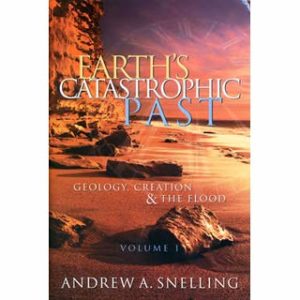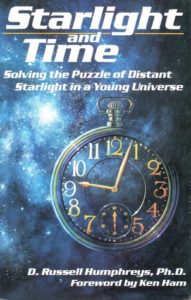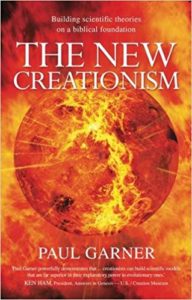(Part 1) (Part 2) The previous post summarized the classic global flood model proposed by John Whitcomb and Henry Morris. This post examines current model by looking primarily, but not exclusively, at the work of Andrew Snelling.
Current Global Flood Models
Whitcomb and Morris inspired a generation of young-earth creationists. One such YEC proponent is Australian geologist Andrew Snelling. Snelling wrote the two volume Earth’s Catastrophic Past: Geology, Creation, and the Flood for the purpose of updating the flood model presented in The Genesis Flood. But in many ways Snelling’s work is a total revamp. Snelling, along with other YEC researchers such as paleontologist Kurt Wise and astrophysicist Russell Humphreys, recognize that the case argued by Whitcomb and Morris needed significant retooling. Nine notable features are:
Drops the Canopy Theory: Significantly, Snelling abandons the canopy theory (663-67). He and other current YEC advocates recognize that the biblical evidence for the canopy theory is tenuous at best. Some, such as Joseph Dillow, did extensive work to provide a viable model but today most YEC proponents have given up on the theory.
Snelling points out there are simply too many scientific obstacles. Any such canopy would have created a runaway greenhouse effect that would have boiled the earth. He explains,
“One consideration is that much more than a few inches of liquid water equivalent in a vapor canopy appears to lead to a runaway greenhouse effect. A second is that the amount of latent heat released from the condensation of water vapor limits the amount of condensation than can occur during the Flood without boiling the oceans and killing all the life on earth because of the high temperatures required to radiate the latent heat to space at a sufficient rate. These considerations imply that even if a water vapor canopy did exist above the atmosphere, it could not have contained sufficient water vapor to have sustained forty days and nights of intense, global, torrential rainfall.” (472-73)
Snelling accepts Humphrey’s idiosyncratic interpretation that the “waters above the expanse” mentioned in Gen 1:6-8 are located on the other side of the universe. So where did the floodwaters come from? Snelling, along with others, argue for “catastrophic plate tectonics” (CPT). They suggest that subterranean reservoirs were unleashed during a catastrophic shift in the tectonic plates. The seismic activity exhibited today by plate tectonics is the residual effect of Noah’s flood. In addition to dropping Whitcomb and Morris’ canopy theory, Snelling also abandons the view that it did not rain prior to the flood (Gen 2:4-7). (669-73)
So where did the floodwaters come from? Snelling, along with others, argue for “catastrophic plate tectonics” (CPT). They suggest that subterranean reservoirs were unleashed during a catastrophic shift in the tectonic plates. The seismic activity exhibited today by plate tectonics is the residual effect of Noah’s flood. In addition to dropping Whitcomb and Morris’ canopy theory, Snelling also abandons the view that it did not rain prior to the flood (Gen 2:4-7). (669-73)
Drops the Notion that the 2nd Law of Thermodynamics Is an Effect of the Curse: Snelling, along with other global flood advocates, realize that Whitcomb and Morris’ argument that entropy was a manifestation of the curse was extremely problematic.(620) Without the second law in force no normal process would be able to function. For example, the second law is necessary for digestion. Whitcomb and Morris’ theory also seemed to be contrary to certain biblical passages. The Bible states that Eden had four rivers (Gen 2:10-14). Rivers are channels of water flowing from a higher level to a lower level. By definition they are examples of the second law in action.
Accepts the Geological Column: Snelling departs from Whitcomb and Morris at another significant point in that Snelling accepts the validity of the geological column. The column is real, and so is the sequence of the fossil record. (329-54) However, Snelling contends that the geological strata do not present a chronological record. Rather they give evidence of geographical distinctions. The four broad geological divisions—the Precambrian, the Paleozoic, the Mesozoic, and the Cenozoic—give evidence of four distinct bio-geographical regions. This forms the basis of the “ecological zonation theory,” which we will examine shortly.
Drops the Paluxy River Fossils: Snelling makes no mention of the fossils found in the riverbed of the Paluxy River. To their credit, most young-earth proponents (with a few notable exceptions) admit that the supposedly human footprints are in fact not human at all. Henry Morris’ son, John Morris publicly acknowledges that none of the prints “can today be regarded as unquestionably of human origin.”
Humans and Dinosaurs Lived at the Same Time but in Different Regions: The current global flood model must account for the fact that the remains of dinosaurs and those of humans are never found in the same geological strata. Snelling and others posit the “ecological zonation theory.” YEC proponents argue that the pre-flood world was segregated into highly distinct zones. Garner explains, “According to the ecological zonation theory, the order of burial of adjacent ecological zones by the encroaching flood waters produced a vertical sequence of rock layers containing characteristic fossils.”
The current global flood model must account for the fact that the remains of dinosaurs and those of humans are never found in the same geological strata. Snelling and others posit the “ecological zonation theory.” YEC proponents argue that the pre-flood world was segregated into highly distinct zones. Garner explains, “According to the ecological zonation theory, the order of burial of adjacent ecological zones by the encroaching flood waters produced a vertical sequence of rock layers containing characteristic fossils.” (199-202) Dinosaurs and humans ate different foods, so then they probably also lived in separate regions or “biome.”
(199-202) Dinosaurs and humans ate different foods, so then they probably also lived in separate regions or “biome.”
Floating continents: One serious challenge to the global flood model is the amount of coal and oil deposits located in the earth. Such deposits are the remnants of buried vegetation. There simply could not have been enough vegetation growing on the earth at one time to account for all the deposits that have been found. As a solution, Snelling, along with Wise and others, propose that during the pre-flood era there existed giant floating continents. Upon these floating islands, which covered much of the world’s oceans, grew immense forests. Kurt Wise explains,
“Based upon this, it has been proposed that the Primary plants actually formed the basis of a large floating forest biome. Based upon how much organic material made up the coals of the Primary, this floating forest may have been subcontinent-sized or even continent-sized. The basic structure was probably broadly similar to the “quaking bogs” found on a number of lakes in the upper Midwestern United States. Quaking bogs are floating vegetation mats whose outer edges are made up of aquatic plants.” (171)
Thus Snelling, Wise, and other global flood proponents hope to account for the immense seams of coal and the oil fields that geologists find throughout the world.
Suspension of the Normal Laws of Nature: Snelling concedes that much of the geological evidence cannot be reconciled with any interpretation that uses the physical laws, properties and relationships as they presently are. He postulates that God miraculously changed the laws of nature during the Flood. Snelling explains,
“Coal beds were formed during the Flood year, approximately 4,500 years ago, as were many of the granites that contain uranium and polonium radiohalos, because the granites intruded into Flood-deposited strata. Thus, it is concluded that hundreds of millions of years worth of radioisotope decay (at today’s measured rates) must have occurred during the Flood year, only about 4,500 years ago.” (847-48)
Appealing to a change in the laws of nature marks a remarkable change in YEC strategy, and in many ways it also makes a significant admission. As a strategy, it indicates an end to any real attempt to empirically establish the historicity of a global flood. Miracles, by definition, cannot be scientifically examined. The appeal also admits that the scientific evidence does not support the YEC model.
Compressed ice ages: Standard geological models hold that during earth’s natural history there have been five distinct ice ages which cover hundreds of millions of years. In addition, mainstream geologists believe that over the last million years there have been a several glacial periods where glacial ice has advanced and retreated. These models, of course, do not fit with a global flood model. Global flood adherents argue that at the very most, from beginning to end, the ice age was only 700 years long. The ice surged out in a “couple of decades,” and then receded within “a couple of decades.” The ice age lasted only a few centuries at the maximum. Therefore, rather than calling it the ice age, Snelling says a more accurate label would be “the ice advance.” (774-86)
Accelerated evolution: Global flood proponents recognize that the ark presents two problems related to speciation: 1) the number of species that were on the ark, and 2) the worldwide distribution of species after they disembarked. The number of species of life on earth is mind-boggling. James LeFanu points out that there are over 40 species of parrots, 70 species of monkeys, tens of thousands of species of butterflies, 20,000 species of ants, 8,000 species of termites—this list goes on and on. There are millions and millions of species.
How did Noah’s ark contain so many different forms of life? And how did so many geographically specific species—such as kangaroos in Australia—disperse so quickly? The solution proposed by global flood advocates is one of the most controversial aspects of the model: a theory called AGEing process (where AGE stands for Altruistic Genetic Elements). Snelling argues that instead of gathering the myriad of species, it was only necessary to gather progenitors who were specimens of each “created kind.” For example instead of loading dogs, wolves, hyenas, coyotes, and other canines onto the ark, it was necessary to have a male and female proto-canine (what he calls “baramin”). Then the number of required animals drop significantly. Snelling explains, “If, as the preponderance of evidence shows, the ‘created kind’ or baramin was possibly equivalent in most instances to the family (at least in the case of mammals and birds), then there would have only been about 2,000 animals on the Ark.” (136)
The global flood model requires that a rapid diversification of species occurred immediately after the Flood. So proponents posit that species proliferated and dispersed in a matter of decades. Garner suggests that the creatures were “frontloaded” with genetically recessive traits that expressed when needed. He admits that in this area YEC has much more work to do, that there are “many as yet unanswered questions.” (140-41) Wise argues that many of the vestigial organs are the result of the rapid evolution that occurred after the animals left the ark. (219-21)
Hugh Ross accuses proponents of the AGEing process of being “hyperevolutionists” who out-Darwin the Darwinists. Ross considers it ironic that, in their attempt to rescue the global flood model, YEC adherents are embracing a version of “ultra-efficient biological evolution.” He observes, “This efficiency of natural speciation exceeds by many orders of magnitude the most optimistic Darwinist estimate ever proposed….If naturalistic evolutionary processes actually did proceed with such speed, the changes would be easily observable in real time—in our time.” (121-30)
Ross considers it ironic that, in their attempt to rescue the global flood model, YEC adherents are embracing a version of “ultra-efficient biological evolution.” He observes, “This efficiency of natural speciation exceeds by many orders of magnitude the most optimistic Darwinist estimate ever proposed….If naturalistic evolutionary processes actually did proceed with such speed, the changes would be easily observable in real time—in our time.” (121-30)
(This post is an excerpt from 40 Questions about Creation and Evolution, coauthored by Mark Rooker and me. The next post will look at critiques of Global Flood Geology.)

https://waterfallmagazine.com
I don’t even know the way I stopped up here, but I thought
this put up was good. I do not know who you
are but definitely you’re going to a famous blogger when you are not already.
Cheers!